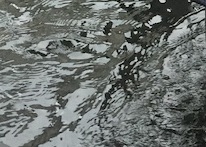Part of a series exploring stories and images of the Bible, and allowing them to breathe. You can read the introduction to the series here.
Genesis opens with not one but two different stories of creation. It’s a beautiful way of teaching that life holds more complexity than a single perspective can convey. It also signals that scripture is up to the challenge of dealing with that complexity.
Offering these two separate accounts makes clear that the value of these stories is not in their literal meaning. Instead, the insight they offer comes from allowing them to speak in a deeper, symbolic way. If the two creation stories were taken literally, they would contradict one another. But stewing over which is “correct” would be to miss the point.

The first story starts with the opening lines of Genesis, and describes beautifully the process of any act of creation. The Creator hovers above the undifferentiated expanse of what is yet to be, brooding over a formless void and gathering the power to begin. This state is echoed in the experience of anyone who tries to bring something new into the world. We begin by allowing ourselves to be in a state of not knowing, and to encounter what is ready to be known but isn’t yet clear.
In the story, the creative power of God is released through speech. God says, “Let there be light.” In the act of naming what is needed, the need is met. This first act of creation calls into being the foundation of life and the illumination of what exists. Light is a basic need, a longing, the energy from which all life arises. It allows us to see. Light represents consciousness—the ability to understand, as well as the capacity for self-reflection. With light, we move forward.
Like plants that turn toward the sun, we orient ourselves toward all that light symbolizes. Yet the story reminds us that creation begins in darkness. It requires an encounter with formlessness and the teeming energy of the unconscious before lifting what we can catch hold of into the light of awareness.
After God creates light and divides it from the darkness, subsequent days in this first story of creation continue to bring order out of chaos—separating the essential elements of the universe, placing them within their proper boundaries, and filling them with life. Creation happens over the course of a seven-day week, with humanity being its culmination. In this story male and female are created at the same time, and they are made in the image of God.
Creation as something inherently good was a strong statement when Genesis was written. It contrasted with the creation stories of surrounding cultures, which depicted life as arising from corrupt beginnings, whether formed by creators of selfish intent or arising from the decaying bodies of vanquished gods.
In the Genesis story, with a reassuring rhythm repeated day by day, God intentionally creates the heavens and the earth. Each new aspect of creation is good. Creativity and dignity are woven into the fabric of human life, as we are made in the image of the Creator, with calendars that echo the week in which the universe was created.
On the seventh day God rests, marking the fullness of the work accomplished and honoring the need to be restored. This ancient practice of a day of rest is as much needed now as it has ever been.
